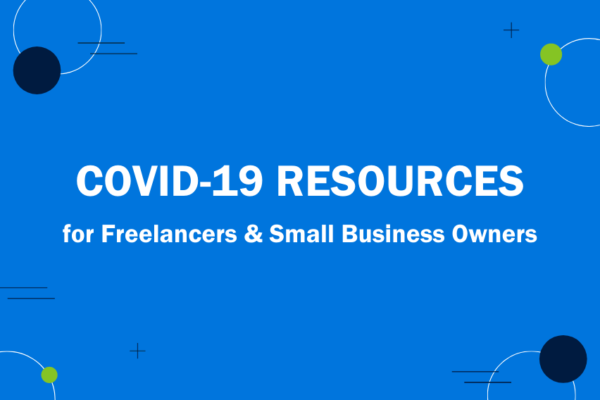A recession guide to help you be prepared, not panicked.

You’ve heard this before, but it’s true: Small businesses are the backbone of our economy. Though small businesses are small, they are mighty. They generate 44% of economic activity in the U.S. And small businesses are extremely vulnerable to economic recession and disaster—25% don’t have enough cash to make it through a two-week downturn.
If your business has ever felt unprepared for tough times, know that you’re not alone. Even the most robust business planning likely doesn’t include preparing for disruptive events like a global pandemic.
Whether your business is struggling because it’s been forced to close or your regular stream of customers has vanished, cash flow is most certainly top-of-mind. How can you stay afloat? This guide will help you prepare for a recession, hopefully without panicking.
Focus on Your Cash Flow
Cash flow is king, but especially during a recession. During good times, cash flow may not have been your priority. With enough money coming in, you probably didn’t have to watch your books too closely to ensure you didn’t run out of money.
A lack of focus on your cash flow can make tough times scary. According to a survey conducted by JP Morgan Chase, the average small business holds 27 cash buffer days in reserve. That means that an average business can continue to meet all of its cash outflows (rent, labor, utilities, etc.) without earning any money for 27 days. But of course not every business falls within this average.
Because cash is so important to keeping a business afloat during tough times, including a recession, do your best to make whatever cash reserves you have last as long as possible. Some key things to do include:
- Collect your receivables: When times are good, it’s easy to let your receivables stretch a little longer than they should. Maybe your net 30 somehow slid to net 45 or even net 60. That’s not going to fly anymore. Follow up on any that are past due and collect your receivables now. Consider adding late payment fees to further incentivize prompt payments.
- Double-check your payables: This is another one that is easy to ignore when times are good and you are busy. Look at all of the payables you have outstanding and when they’re due. Double-check all totals to ensure they’re accurate. And if necessary, stretch out payments to their due dates.
- Review your books: If you haven’t been running your business with a strict budget, now is the time to start. Start by looking at your current expenses. Cut any unused subscriptions or services: trade publications, a stock photo subscription. Challenge yourself to find creative ways to cut an expense, without impacting your business. Don’t ruthlessly cut everything, but it’s time to trim the excess.
- Contact your lenders: If you know that you’re going to struggle making your loan payments during a recession, get ahead of this now. Contact your lenders to see what leeway they may be able to offer you. Ultimately, they’d rather work with you on your payments that see you default.
- Negotiate with vendors: What are your current terms for paying your vendors? If you pay upon receipt, it might be worth asking if you can pay net 30 or even net 60 to get you through the next month or so. Your vendors may not say yes (after all, they’re probably dealing with their own cash issues), but you won’t know until you ask.
Get Creative to Weather a Recession
While your primary business may be suffering, is there an opportunity to expand to serve customers in a different way? Breweries in Oregon, left without the ability to serve customers onsite during the pandemic, started home delivery services. Their loyal fans get craft brews that they can’t find in the grocery stores.
Maybe you’re a caterer who has seen business dry up with event cancellations. Could you create a food delivery service packing people’s refrigerators full of healthy staples like gourmet salads, soups, and daily smoothies?
Or perhaps you’re a personal trainer and you have to stop seeing clients. You might offer discounted virtual sessions to clients.
We’ve also seen many small businesses offer gift cards to their loyal customers as a way of getting cash in their pockets sooner (though, granted, they’ll still owe services for those advances down the road). And companies are helping to make this easy. For example, Shopify is making physical and digital gift cards available for all businesses they support.
These ideas don’t have to be a long-term solution—think about how you can take the resources you have right now and meet the needs of the people in your community.
Explore Your Financing Options
The best time to look at loans and lines of credit is before you need them. Even if you think you can weather this storm and recession without borrowing money, take the time to learn your options now. If you don’t have an immediate need for money, or a set amount that you need, a flexible option like a revolving line of credit might be a good choice.
- SBA CAPLines: The Small Business Administration (SBA) is known for their loans. But they also offer lines of credit. There are four CAPLine options designed to meet businesses short-term needs for cash. Just like with SBA loans, these lines of credit aren’t actually from the SBA but the SBA guarantees a percentage, making them less risky for traditional lenders.
- Business credit cards: If you don’t have a business credit card, now is the time to get one. Depending on your credit, you may even qualify for a 0% APR credit card. This can be valuable to have to use in case of an emergency.
- Invoice financing or factoring: An often-overlooked form of financing is invoice financing or factoring. With invoice factoring you sell your unpaid invoices to a factoring company for a percentage upfront and you’ll receive the remainder, minus a fee, when the invoice is paid. Factoring can get expensive, but if you need cash before your invoices are paid, it’s an option to get you through a rough spot.
Look Into Disaster Relief
While there is still plenty of access to traditional capital, there are also disaster relief options that are being updated daily. These include:
- SBA Disaster Relief Loans: These are low-interest loans (3.75% for small businesses and 2.75% for nonprofits) to help business owners and homeowners recover from disasters. COVID-19 is a declared disaster and now states are able to offer loans up to $2 million to small businesses suffering as a result of the virus.
- Facebook grant: Facebook is offering $100 million in grants for struggling small businesses affected by COVID-19. It hasn’t released details of how to apply, but you can sign up for updates on its website.
- Local resources: Check your local resources to see what is available to businesses that may be struggling at the moment. For example, the San Francisco Small Business Resiliency Fund provides up to $10,000 to help pay employee salaries and rent.
This FreshBooks article provides a more extensive listing of resources and is updated daily.
Check Your Insurance
If you have business insurance, now is a great time to break out your policy. One thing to specifically check for is a business interruption policy. Business interruption insurance is designed to protect businesses from the loss of income resulting from a disaster.
If you do have business interruption insurance, it’s time to dig into the details. Your plan may specifically say it won’t cover economic losses related to a virus or recession, but it’s worth checking.
Keep up Communication With Your Customers
Above all, keep in communication with your customers. You’ve worked to develop a business based on their trust. Don’t leave them guessing. Communicate when you’re closed, when you expect to reopen and any additional offerings you have. Tell them how you’re here to support them and how they can help to support you.
In a time where so many people are afraid of what’s next (including you), connections matter.
Bottom Line
Your business matters to you, to your customers, and to the economy. While no one knows what’s coming next, guiding your business through tough times can leave you stronger on the other side.

Written by Erica Gellerman, Freelance Contributor
Posted on March 24, 2020

 Managing Your Business During Uncertain Times
Managing Your Business During Uncertain Times COVID-19 Resources for Freelancers and Small Business Owners
COVID-19 Resources for Freelancers and Small Business Owners Managing Remote Teams? These 15 Amazing Collaboration Tools Can Help
Managing Remote Teams? These 15 Amazing Collaboration Tools Can Help





